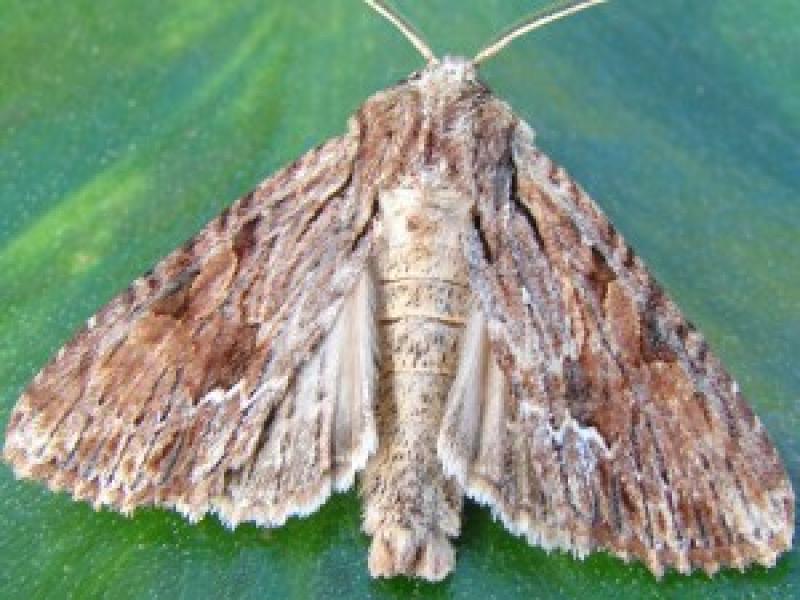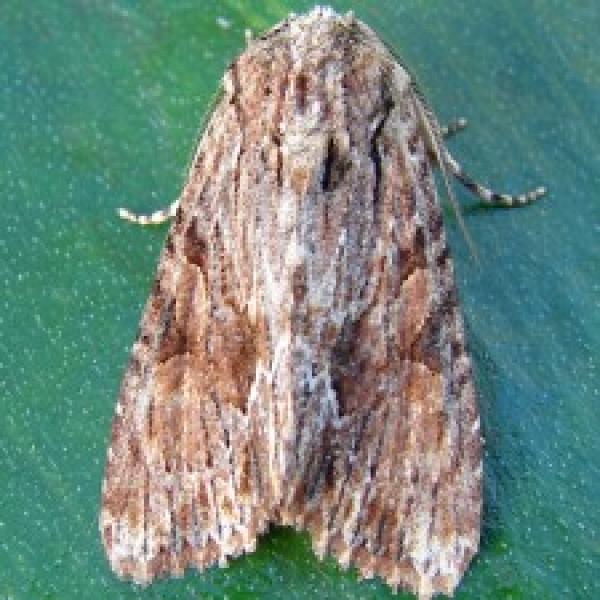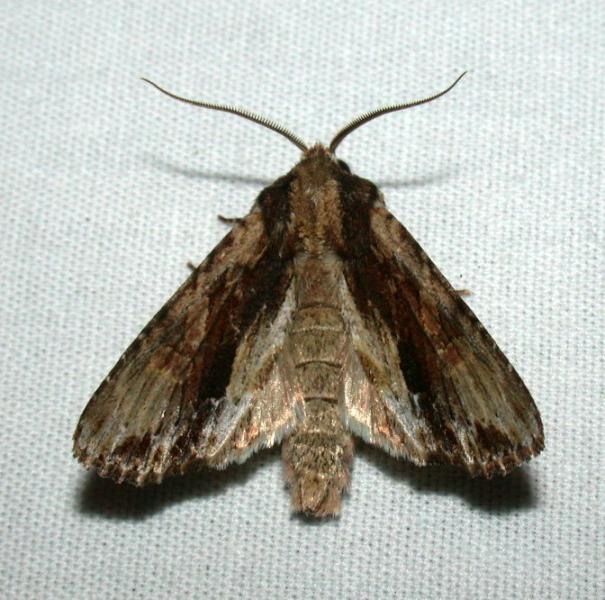Gray Woodgrain
Morrisonia mucens (Hübner, [1831])
- Class
- Insecta (Insects)
- Family
- Noctuidae (Owlet Moths)
- State Protection
- Not Listed
Not listed or protected by New York State.
- Federal Protection
- Not Listed
- State Conservation Status Rank
- S1S3
Critically Imperiled, Imperiled, or Vulnerable in New York - Conservation status is uncertain; could be especially vulnerable, very vulnerable, or vulnerable to disappearing from New York, due to rarity or other factors. More information is needed to assign either S1, S2 or S3.
- Global Conservation Status Rank
- G4G5
Apparently or Demonstrably Secure globally - Uncommon to common in the world, but not rare; usually widespread, but may be rare in some parts of its range; possibly some cause for long-term concern due to declines or other factors. More information is needed to assign either G4 or G5.
Summary
Did you know?
This moth species belongs to a group called the Dart or Cutworm Moths. They are given those names for good reasons. When resting, the moths hold their wings back in a triangular "dart-like" position. They also cut plant stems off at the base by chewing on them near the soil level.
State Ranking Justification
The Gray Woodgrain is a barrens specialist. Currently, in New York State, this species is known from Napeague State Park and the dwarf pine barrens on Long Island. Future inventories may locate this species at other pine barrens type habitats on Long Island and possibly off the coastal plain.
Short-term Trends
This species appears to be stable on Long Island. Surveys since 1993 have indicated very little change in the dwarf pine barrens population on Long Island, with the exception of 2005 surveys, which showed a significant increase in numbers of moths. It is possible that previous forest fires in the dwarf pine plains caused an increase in habitat for this species.
Long-term Trends
The long-term trend for this species is tied to the long-term trend of the natural community it lives in. The acreage of dwarf pine plains in New York has declined from development, although there is still a large occurrence of this habitat type on Long Island.
Conservation and Management
Threats
Known threats include habitat loss due to development and fire suppression, although the threat of development for the remaining habitat on Long Island may be low. The suppression of fires in barrens and other dry places would cause a loss of habitat for the species and therefore a reduction in population size. This species requires open woodlands or barrens with pitch pine and scrub oaks. Forest fires are needed, on average, every 5-10 years (Jordan et al. 2003) to maintain this type of habitat. Lack of fires will result in the succession of this community to a closed-canopy forest of tall oaks and other hardwoods (Little 1979, Jordan et al. 2003). Conversely, a fire affecting an entire occurrence could eliminate all life stages that are present.
Conservation Strategies and Management Practices
The best management strategy for this species is the management of the natural community, or habitat, where this species occurs. Maintaining the Long Island pine barrens with their full suite of plant and animal species requires frequent (every few decades) disturbance to maintain open-canopy, shrub-dominated communities and to prevent succession to a closed-canopy hardwood forest (Jordan et al. 2003). Researchers have determined that "an active fire management program utilizing prescribed fire with appropriate mechanical treatments" is the preferred method (Jordan et al. 2003). Researchers have also determined that the size, type, intensity, and timing of fires (pyrodiversity) needs to be evaluated for each site to maximize benefits to the natural community and the species it supports (Jordan et al. 2003). The entire occupied habitat for a population should not be burned in a single year. For example, in places where prescribed burning is used, refugia (unburned areas) are needed for many species to ensure that any life stage can survive a fire.
Research Needs
Additional surveys are needed with bait and blacklight traps to determine the extent of the dwarf pine barrens occurrence on Long Island. In addition, research is needed on the response of this species to prescribed (controlled) burning and mechanical treatment to improve habitat.
Habitat
Habitat
In New York State, this species is found exclusively in the open-canopy dwarf pine barrens and pitch pine-oak heath woodlands of Long Island. Pitch pine and scrub oak are the dominant plant species in both of these habitats. It is suspected that the larval food source is scrub oak.
Associated Ecological Communities
- Dwarf pine plains
(guide)
A woodland community dominated by dwarf individuals of pitch pine and scrub oak that occurs on nearly level outwash sand and gravel plains in eastern Long Island. The soils are infertile, coarse textured sands that are excessively well-drained.
- Pitch pine-oak-heath woodland
(guide)
A pine barrens community that occurs on well-drained, infertile, sandy soils. The structure of this community is intermediate between a shrub-savanna and a woodland. Pitch pine and white oak are the most abundant trees.
Associated Species
- Burgess's Apamea (Apamea burgessi) (guide)
- Herodias Underwing (Catocala herodias)
- Jair Underwing (Catocala jair)
- Melsheimer's Sack Bearer (Cicinnus melsheimeri) (guide)
- Packard's Lichen Moth (Cisthene packardii) (guide)
- Projecta Gray (Cleora projecta) (guide)
- Pine Tussock Moth (Dasychira pinicola) (guide)
- A Geometrid Moth (Euchlaena madusaria) (guide)
- Fringed Dart (Eucoptocnemis fimbriaris) (guide)
- Violet Dart (Euxoa violaris) (guide)
- Coastal Barrens Buckmoth (Hemileuca maia ssp. 5) (guide)
- Yellow-spotted Graylet (Hyperstrotia flaviguttata) (guide)
- Pale Green Pinion Moth (Lithophane viridipallens) (guide)
- Pin-striped Slug Moth (Monoleuca semifascia) (guide)
- Pink Sallow (Psectraglaea carnosa) (guide)
- Spinose Flower Moth (Schinia spinosae) (guide)
- Barrens Itame (Speranza exonerata) (guide)
- Gordian Sphinx (Sphinx gordius) (guide)
- Toothed Apharetra (Sympistis dentata) (guide)
- Orange Holomelina (Virbia aurantiaca) (guide)
- Pine Barrens Zale (Zale lunifera) (guide)
Range
New York State Distribution
The Gray Woodgrain appears to be restricted to coastal plain pine barrens, indicating that in New York State it would be limited to Long Island, although it might possibly also be located off the coastal plain.
Global Distribution
The Gray Woodgrain is known from Long Island, New York, south to Florida, and west to Ohio and Texas (Covell 1984).
Best Places to See
- Napeague State Park (Suffolk County)
Identification Comments
Identifying Characteristics
The forewing of the Gray Woodgrain is mixed gray and brown. Look for two blackish triangular patches at the outer margin (Covell 1984).
Best Time to See
The adults of this species are active in the late spring.
- Present
- Reproducing
The time of year you would expect to find Gray Woodgrain present and reproducing in New York.
Gray Woodgrain Images
Taxonomy
Gray Woodgrain
Morrisonia mucens (Hübner, [1831])
- Kingdom Animalia
- Phylum Arthropoda
(Mandibulates)
- Class Insecta
(Insects)
- Order Lepidoptera
(Butterflies, Skippers, and Moths)
- Family Noctuidae (Owlet Moths)
- Order Lepidoptera
(Butterflies, Skippers, and Moths)
- Class Insecta
(Insects)
- Phylum Arthropoda
(Mandibulates)
Additional Resources
References
Covell, Charles V. 1984. A field guide to the moths of eastern North America. Houghton Mifflin Company, Boston.
Forbes, William T. M. 1954. Lepidoptera of New York and neighboring states part III. Cornell University Experiment Station Memoir 329.
Jordan, M. J., W. A. Patterson III, A. G. Windisch. 2003. Conceptual ecological models for the Long Island pitch pine barrens: implications for managing rare plant communities. Forest Ecology and Management 185, 151-168.
Little, S. 1979. Fire and plant succession in the New Jersey pine barrens. pp. 297-313 in Forman, R.T.T. (ed.) Pine Barrens: Ecosystem and Landscape. Academic Press, Inc. Orlando, FL.
McGuinness, Hugh. 2006. Overview of the 2005 Dwarf Pine Plains data.
NatureServe. 2010. NatureServe Explorer: An online encyclopedia of life [web application]. Version 7.1. NatureServe, Arlington, Virginia. Available http://www.natureserve.org/explorer. (Data last updated August 2010)
New York Natural Heritage Program. 2024. New York Natural Heritage Program Databases. Albany, NY.
North American Moth Photographers Group at the Mississippi Entomological Museum. No date. Mississippi State University, Mississippi. http://mothphotographersgroup.msstate.edu/MainMenu.shtml
Wagner, David L., Nelson, Michael W., and Schweitzer, Dale F. 2003. Shrubland Lepidoptera of southern New England and southeastern New York: ecology, conservation, and management. Forest Ecology and Management 185: 95-112.
Links
About This Guide
This guide was authored by: Lauren Lyons-Swift
Information for this guide was last updated on: December 19, 2011
Please cite this page as:
New York Natural Heritage Program. 2024.
Online Conservation Guide for
Morrisonia mucens.
Available from: https://guides.nynhp.org/gray-woodgrain/.
Accessed July 26, 2024.


